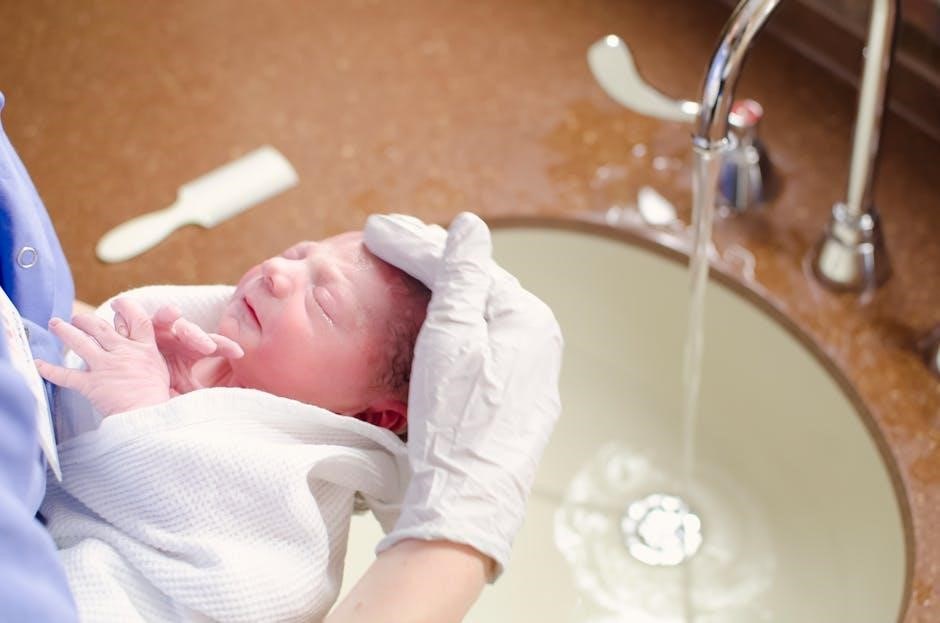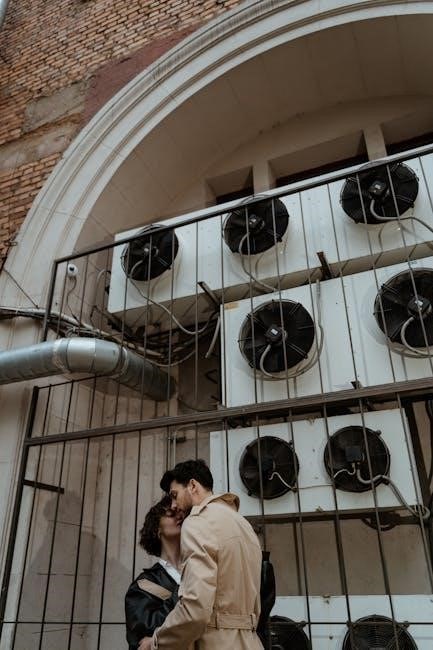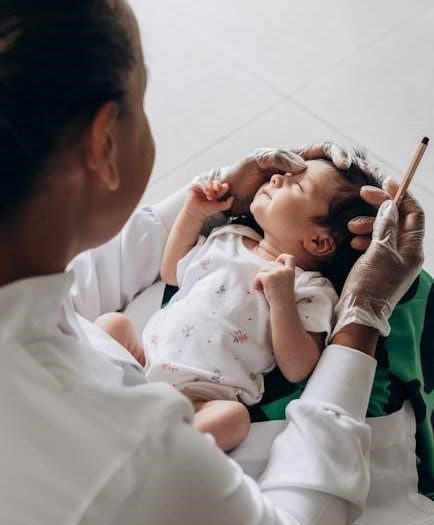Neonatal ventilator settings are critical for supporting respiratory function in newborns with respiratory distress. Proper settings minimize lung injury and optimize gas exchange, ensuring individualized care for each neonate.
Understanding ventilator mechanics and clinical guidelines is essential for healthcare providers to deliver safe and effective respiratory support, tailored to the specific needs of premature or critically ill infants.
1.1 Overview of Neonatal Ventilation
Neonatal ventilation is a lifesaving intervention for newborns with respiratory distress, supporting their breathing and ensuring adequate gas exchange. It involves various modes, such as pressure control and volume-targeted ventilation, tailored to the infant’s needs. The goal is to maintain lung volume and minimize injury while promoting normal lung development. Ventilation strategies must be synchronized with the infant’s spontaneous efforts to enhance comfort and reduce complications. Proper setup and continuous monitoring are crucial to optimize outcomes and prevent long-term pulmonary damage.
1.2 Importance of Proper Ventilator Settings in Neonatal Care
Proper ventilator settings are vital to ensure effective gas exchange, maintain lung volume, and minimize the risk of complications such as ventilator-associated lung injury (VALI) and chronic lung disease (CLD). Incorrect settings can lead to volutrauma or barotrauma, potentially causing long-term pulmonary damage. Individualized adjustments based on the neonate’s condition, such as respiratory mechanics and disease severity, are essential. Synchronized ventilation with the infant’s spontaneous breathing efforts further enhances comfort and reduces complications, emphasizing the critical role of precise settings in neonatal care.

Key Principles of Neonatal Ventilation
Neonatal ventilation focuses on supporting the infant’s respiratory system while minimizing lung injury. Key principles include synchronizing ventilation with spontaneous breathing, using appropriate PIP and PEEP, and ensuring personalized adjustments.
2.1 Understanding Lung Mechanics in Neonates
Understanding lung mechanics in neonates is crucial for effective ventilation. Neonatal lungs are highly compliant but lack surfactant, leading to increased work of breathing and susceptibility to injury.
Key factors include tidal volume, lung compliance, and resistance. Proper ventilator settings help maintain functional residual capacity, preventing atelectotrauma and optimizing gas exchange for fragile neonatal lungs.
2.2 Principles of Gas Exchange and Ventilatory Support
Effective gas exchange in neonates relies on maintaining adequate ventilation-perfusion matching. Ventilatory support aims to enhance oxygenation and carbon dioxide removal while minimizing lung stress.
Strategies include optimizing PEEP to prevent alveolar collapse and adjusting FiO2 to achieve target SpO2 levels. Synchronized ventilation modes further improve gas exchange by aligning ventilator breaths with the infant’s respiratory efforts.
2.3 Minimizing Lung Injury During Mechanical Ventilation
Minimizing lung injury during neonatal ventilation is crucial to prevent long-term pulmonary complications. Strategies include using low tidal volumes, maintaining appropriate PEEP levels, and avoiding excessive pressures.
Synchronized ventilation modes and gentle inspiratory times help reduce barotrauma and volutrauma. Regular monitoring of blood gases and clinical status ensures optimal, lung-protective ventilator settings.

Modes of Neonatal Ventilation
Neonatal ventilation modes include conventional, advanced, and synchronized options. These methods support respiratory function, reduce injury risk, and improve outcomes in critically ill newborns.
3.1 Conventional Modes of Ventilation
Conventional ventilation modes include Pressure Control, Volume Control, and Assist/Control. These modes provide essential respiratory support, minimizing lung injury in neonates with respiratory distress. Pressure Control is often used for preterm infants, while Volume Control ensures consistent tidal volumes; Assist/Control synchronizes with the neonate’s breaths, enhancing comfort and effectiveness. These modes are tailored to conditions like RDS and obstructive lung diseases, focusing on optimal PIP, PEEP, and inspiratory time settings to improve gas exchange and lung recruitment.
3.2 Advanced Modes of Ventilation (HFOV, NIV)
Advanced ventilation modes like High-Frequency Oscillatory Ventilation (HFOV) and Non-Invasive Ventilation (NIV) offer specialized respiratory support. HFOV delivers small tidal volumes at high frequencies, ideal for preterm infants with severe respiratory distress syndrome (RDS) when conventional methods fail. NIV, including CPAP and BiPAP, provides non-invasive support, increasing lung volume and reducing the work of breathing. These modes are tailored to neonatal needs, minimizing lung injury and aligning with clinical guidelines to enhance respiratory outcomes in critically ill newborns.
3.3 Synchronized Ventilation Modes
Synchronized ventilation modes, such as SIMV (Synchronized Intermittent Mandatory Ventilation) and ASV (Adaptive Support Ventilation), align ventilatory support with the neonate’s spontaneous breathing efforts. These modes improve lung mechanics, reduce work of breathing, and promote a more physiologic respiratory pattern. By synchronizing with the infant’s breaths, they enhance comfort and reduce the risk of lung injury. This approach is particularly beneficial for neonates with evolving respiratory failure, supporting their transition to spontaneous breathing and improving long-term pulmonary outcomes.

Ventilator Settings for Common Neonatal Conditions
Ventilator settings vary for conditions like RDS, obstructive diseases, and pneumonia, requiring tailored adjustments in PIP, PEEP, FiO2, and inspiratory time to optimize neonatal respiratory support effectively.
4.1 Settings for Respiratory Distress Syndrome (RDS)
For neonates with RDS, ventilator settings focus on maintaining adequate lung expansion and gas exchange. Initial PIP settings typically range from 15-25 cmH₂O, with PEEP at 4-6 cmH₂O to prevent alveolar collapse. Inspiratory time is usually 0.3-0.6 seconds, and the I:E ratio is often 1:1. Surfactant therapy is critical, and synchronized ventilation modes are preferred to reduce lung injury. Adjustments are made based on blood gas analysis, aiming for preductal SpO₂ of 91-95%. Regular monitoring ensures optimal support while minimizing barotrauma and volutrauma risks.
4.2 Settings for Obstructive Lung Diseases
For obstructive lung diseases in neonates, ventilator settings aim to address airway resistance and promote secretion clearance. Inspiratory time is typically longer (0.4-0.8 seconds), with an I:E ratio of 1:1.5 to 1:2. PIP ranges from 18-28 cmH₂O, and PEEP is set at 5-7 cmH₂O to maintain airway patency. Higher flow rates (6-8 L/min) may be used to reduce resistance. The goal is to improve ventilation while avoiding hyperinflation. Synchronized modes are preferred, and settings are adjusted based on clinical response and gas exchange. Regular suctioning and humidification are also critical to manage secretions effectively.
4.3 Settings for Neonatal Pneumonia
For neonatal pneumonia, ventilator settings focus on maintaining adequate oxygenation and clearing secretions. PIP is typically set between 20-25 cmH₂O, with PEEP at 5-8 cmH₂O to prevent atelectasis. FiO₂ is adjusted to maintain SpO₂ between 88-94%. Inspiratory time is usually 0.4-0.6 seconds, and the respiratory rate is tailored to the infant’s needs. Synchronized modes are preferred to support the infant’s respiratory effort. Regular suctioning and humidification are essential to manage airway secretions. Adjustments are made based on clinical response and blood gas analysis to optimize ventilation and minimize lung injury.

Adjusting Ventilator Parameters
Adjusting ventilator parameters requires careful assessment of clinical response and blood gas analysis. Changes are made to optimize lung mechanics, ensuring adequate ventilation while minimizing injury.
5.1 Adjusting PIP and PEEP Levels
Adjusting PIP (Peak Inspiratory Pressure) and PEEP (Positive End-Expiratory Pressure) levels is critical for optimizing neonatal ventilation. PIP should be set to achieve adequate tidal volumes while minimizing barotrauma. PEEP prevents alveolar collapse, improving oxygenation. Initial PIP levels typically range from 15-25 cmH2O, and PEEP from 4-6 cmH2O. Adjustments are guided by blood gas analysis, chest X-rays, and clinical response. Fine-tuning these pressures ensures lung protection and effective gas exchange, balancing ventilatory support with the risk of lung injury in fragile neonatal patients. Regular monitoring is essential to maintain optimal settings.
5.2 Setting Inspiratory Time and I:E Ratio
Inspiratory time (I Time) and the inspiratory-to-expiratory (I:E) ratio are critical for synchronizing ventilation with the neonate’s breathing pattern. Typical I Time ranges from 0.3 to 0.6 seconds, while the I:E ratio is often 1:1 for respiratory distress syndrome (RDS) and 1:1.5 or 1:2 for obstructive lung diseases. Adjustments aim to optimize gas exchange, prevent air trapping, and minimize lung injury. These settings are tailored based on clinical assessment and blood gas analysis to ensure ventilatory support aligns with the neonate’s physiological needs.
5.3 Managing Tidal Volume and Respiratory Rate
Tidal volume (Vt) should be set between 4-8 mL/kg to avoid lung injury while ensuring adequate ventilation. Respiratory rate is typically adjusted between 30-60 breaths per minute, depending on the neonate’s condition. For preterm infants with RDS, higher rates may be necessary to maintain proper gas exchange. Synchronization with the neonate’s spontaneous breathing is crucial to prevent asynchrony. Adjustments are guided by blood gas analysis, aiming for a pH range of 7.25-7.45 and PaCO2 levels of 40-60 mmHg to optimize ventilatory support and minimize complications.

Complications and Their Management
Ventilator-associated lung injury (VALI) and air leak syndromes are common complications. Management includes optimizing PEEP, avoiding excessive tidal volumes, and using gentle ventilation strategies to mitigate lung damage.
6.1 Ventilator-Associated Lung Injury (VALI)
Ventilator-associated lung injury (VALI) is a major complication in neonatal ventilation, caused by mechanical stress from high pressures or volumes. It can lead to inflammation, edema, and long-term pulmonary damage. Minimizing barotrauma and volutrauma is critical. Strategies include using protective ventilation with lower tidal volumes, optimizing PEEP, and avoiding excessive FiO2. Non-invasive ventilation modes, such as NIV, may reduce VALI risk. Regular monitoring of lung mechanics and blood gases helps early detection and adjustment of ventilator settings to mitigate injury and improve outcomes.
6.2 Air Leak Syndromes and Their Management
Air leak syndromes, such as pneumothorax and pulmonary interstitial emphysema, are complications of neonatal ventilation. They occur due to elevated intrathoracic pressures causing air to escape into tissues. Management involves reducing ventilator pressures, adjusting PEEP levels, and ensuring proper endotracheal tube placement. Non-invasive ventilation may be considered to minimize further injury. Surfactant therapy can improve lung compliance, reducing the risk of air leaks. Close monitoring of clinical signs and imaging is essential for early detection and intervention, ensuring optimal outcomes for ventilated neonates.

6.3 Chronic Lung Disease (CLD) Prevention
Chronic Lung Disease (CLD) in neonates is often linked to prolonged mechanical ventilation and lung injury. Preventive strategies include the use of non-invasive ventilation, surfactant therapy, and gentle ventilator settings to minimize barotrauma and volutrauma. Early weaning from ventilation and maintaining optimal PEEP levels are crucial. Additionally, ensuring adequate nutrition and oxygen saturation targets helps reduce the risk of CLD, promoting healthier lung development in vulnerable newborns.
Regular monitoring of lung mechanics and blood gas analysis allows for timely adjustments in ventilatory support, further reducing the likelihood of long-term respiratory complications. This holistic approach ensures neonates receive the most protective and effective respiratory care possible.

Guidelines for Ventilator Setup

Proper ventilator setup involves selecting appropriate modes, ensuring pressure limits, and synchronizing with the infant’s breathing patterns. Non-invasive methods are prioritized to reduce complications and improve outcomes.
7.1 Setting Up the Servo 300A Ventilator
Setting up the Servo 300A ventilator involves selecting the appropriate mode, such as pressure control, and ensuring tidal volume does not exceed 40cc for neonates. PEEP levels are adjusted based on lung compliance, and synchronization with the infant’s breath is crucial. Pressure alarms are set to prevent barotrauma, and continuous monitoring of respiratory parameters is essential. Regular checks ensure proper function and safety, while documentation of settings aids in tracking progress and adjustments. Proper setup minimizes complications and optimizes respiratory support for critically ill neonates.
7.2 Configuring the Drager Babylog VN500
Configuring the Drager Babylog VN500 involves selecting appropriate modes (volume or pressure control) and setting parameters like PIP, PEEP, inspiratory time, and respiratory rate. For neonates, PIP is typically 15-25 cmH2O, while PEEP is 4-6 cmH2O. Inspiratory time is usually 0.3-0.6 seconds, with an I:E ratio of 1:1 for RDS. Alarm settings are customized based on the infant’s clinical status. Ensure synchronization with the infant’s breath to prevent lung injury. After initialization, continuous monitoring of tidal volume and respiratory parameters is essential for optimal support and safety. Regular power-up checks and maintenance ensure proper function.
7.4 General Safety Features and Alarms
Essential safety features include apnea alarms, high and low pressure alarms, and oxygen level monitoring. These alarms ensure timely intervention and prevent complications. The Drager Babylog VN500 also features an automated shutdown if critical limits are exceeded. Regular checks of sensors and tubing are crucial to maintain accuracy. Alarms are set based on the neonate’s specific respiratory parameters, ensuring personalized safety. These features help minimize risks and provide a secure environment for neonatal ventilation, supporting optimal patient outcomes and caregiver confidence. Proper alarm configuration is vital to prevent false alerts and ensure patient safety. Always follow manufacturer guidelines for setup and monitoring.

Monitoring and Documentation
Continuous monitoring of ventilator parameters ensures optimal respiratory support. Blood gas analysis and real-time data help assess effectiveness. Accurate documentation of settings and adjustments is crucial for consistent care and tracking progress.
Regular checks of tidal volume, rate, and pressures maintain safety and efficacy. Documentation guides clinical decisions and communicates changes effectively among healthcare teams, ensuring personalized and evidence-based care for neonates.
8.1 Blood Gas Analysis and Interpretation
Blood gas analysis is crucial for assessing the effectiveness of neonatal ventilation. It measures pH, PaCO2, and PaO2 levels, providing insights into oxygenation and ventilation status. These results guide adjustments in FiO2, PEEP, and respiratory rate to maintain target ranges. Regular analysis helps prevent hypo- or hypercapnia and ensures optimal acid-base balance. Interpretation of blood gases informs clinical decisions, such as weaning strategies or escalating support. Accurate documentation of these findings is essential for continuity of care and improving patient outcomes in the neonatal intensive care unit.
8.2 Continuous Monitoring of Ventilatory Parameters
Continuous monitoring of ventilatory parameters ensures neonates receive optimal respiratory support. Key parameters include tidal volume, respiratory rate, and inspiratory pressure, which are tracked in real-time. Modern ventilators provide visual displays and alarms for deviations from set limits. This ongoing surveillance allows for prompt adjustments to prevent complications like volutrauma or hypoventilation. Regular checks of airway pressure and flow also ensure proper function of the ventilator circuit. This meticulous monitoring is vital for maintaining stable lung function and achieving desired clinical outcomes in critically ill newborns.
8.3 Documenting Ventilator Settings and Adjustments
Accurate documentation of ventilator settings and adjustments is crucial for maintaining continuity of care. Settings such as tidal volume, PIP, PEEP, FiO2, and respiratory rate should be recorded on both nursing charts and blood gas analysis reports. Daily documentation of ventilator parameters ensures consistency and clear communication among healthcare providers. This practice also aids in tracking progress and identifying trends, facilitating timely adjustments. Regular reviews of documented settings help maintain patient safety and optimize respiratory support in neonatal care.
